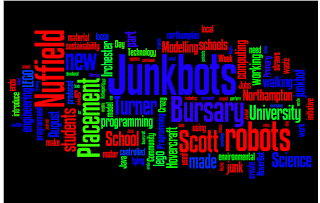Ce poste se fonde sur deux postes précédents et
tente de répondre à certains des commentaires très utiles de personnes qui ont
essayé cela. J'espère que cela aide.
Globalement, le projet se fonde sur un projet
antérieur pour obtenir d'un simple X -Wing dans Minecraft sur un Raspberry Pi
. Le but était obtenir Python pour construire et déplacer le X -Wing . Les
détails de ce projet peuvent être trouvés ici .
Révision Principale: Dans ce projet, et le
précédent est basé autour de Python 3 exécutant le Raspbian ' Jessie ' Novembre
version de l'OS . Aussi les bibliothèques supplémentaires peuvent devoir être
ajouter pour obtenir le minecraftstuff (comme ShapeBlock ( ) et MinecraftShape
( ) ) . Détails sur la façon d' obtenir et d'installer ceux-ci peuvent être
trouvés à
Dans ce post, la supplémentaire de Skywriter de Pirmoroni est inclus pour permettre les mouvements d'une main ou un doigt pour permettre à la X -Wing pour le décollage , la terre , aller de l'avant ou vers l'arrière .
Il se fonde sur des idées du livre Adventures
in Minecraft sur l'utilisation de Python et Minecraft utilisant un Raspberry
Pi .
Le Skywriter est
une HAT Raspberry Pi (voir figure 2 ) qui permet à l'information de position de
la main juste au-dessus du bord. Dans ce projet, il détecte films de la main ,
vers le bas, ou à travers le conseil d'administration afin de déterminer la
direction du mouvement
Avant de
commencer , utilisez le Skywriter dans le terminal que vous devez ajouter
curl -sSL get.pimoroni.com/skywriter | bash
Pour commencer nous avons juste placé le X
-Wing au-dessus du lecteur en plaçant des blocs en forme ( à peu près ) de la X
-Wing basée autour de la méthode MinecraftShape ( voir le chapitre 8 de
Adventures in Minecraft ) .
• Pour éviter de construire sur le joueur la position de départ de la X -Wing est défini par:• Trouver la position du joueur ;
o ajouter 5 à la position x du joueur ;
o ajouter 10 à la position y du joueur ( Le bit je dois me rappeler est l'axe y est vertical. ) ;
o ajouter 5 à la position z du joueur;
• L'utilisation de ces valeurs construire en utilisant des blocs de laine , le X -Wing - 0 pour le blanc , et 14 pour les blocs rouges ;
 • Si un film commence au sommet de la planche (ou «nord» ) cela déplace le X -Wing vers le sol ;
• Si un film commence au sommet de la planche (ou «nord» ) cela déplace le X -Wing vers le sol ;
• Si un film commence au bas de la carte (ou " sud " ) cela déplace le X -Wing verticalement vers le haut ;
• Si un film commence sur la droite de la carte (ou «est» ), le X -Wing se déplace vers l'arrière horizontalement ;
• si un film commence sur la gauche de la carte ( ou « ouest »), le X -Wing se déplace vers l'avant .
from mcpi.minecraft import
Minecraft
from mcpi import block
import mcpi.minecraftstuff
as minecraftstuff
import time
import skywriter
import signal
mc=Minecraft.create()
xPos=mc.player.getTilePos()
xPos.x=xPos.x+5
xPos.y=xPos.y+5
xPos.z=xPos.z+5
xWingBlocks=[
xWingShape=minecraftstuff.MinecraftShape(mc,xPos,xWingBlocks)
@skywriter.flick()
def flick(start,finish):
if
start=="south":
for count in
range(1,10):
time.sleep(0.1)
xWingShape.moveBy(0,1,0)
if
start=="west":
for count in
range(1,10):
time.sleep(0.1)
xWingShape.moveBy(-1,0,0)
if
start=="east":
for count in
range(1,10):
time.sleep(0.1)
xWingShape.moveBy(1,0,0)
if
start=="north":
for count in
range(1,10):
time.sleep(0.1)
xWingShape.moveBy(0,-1,0)
signal.pause()
Pour plus de détails sur Minecraft et Python je
suggère d'aller à
http://www.stuffaboutcode.com/2013/11/coding-shapes-in-minecraft.html~~V en
particulier sur la façon de télécharger le logiciel à mettre en œuvre
MinecraftShape . Si vous n'utilisez ou modifiez cette s'il vous plaît laisser
un commentaire, je serais ravi de voir ce que les autres faire.
All opinions in this blog are the Author's and should not in any way be seen as
reflecting the views of any organisation the Author has any association with.
Translation was done with Google Translate – sorry if it causes any offence this was
not intentional.








